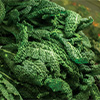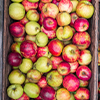
Featured Produce | Summer Quarterly 2019
Featured Produce: Peaches
Nothing says summer like peach juice dripping down your arm.
If you can resist eating them fresh, they can also be grilled, baked into
a pie, canned or made into jam. For something different make a peach
salsa to eat with chips or to top a fish or shrimp taco.
A peach is a deciduous tree native to Northern China. The fruit
is in the stone fruit family and is high in Vitamin C. Peaches and
nectarines are derived from the same species of plant, but peaches are
characterized by the presence of fuzz on the skin, while nectarines are
fuzz-free. The two fruits can generally be substituted for one another
in any recipe.
Peaches have a short season and are generally only available
between July and September. Peach trees need wet winters and hot
dry summers. Locally, they are grown inland in Humboldt County.
The Co-op carries local, organic peaches from Neukom Family Farm
throughout the summer. Learn more about Neukom Family Farm on
page 18.
The perfect ripe peach will show no green and will put off a light,
sweet aroma. It should give a little when you squeeze it, and the
skin should be tight with no wrinkles. Don’t stress if you choose an
underripe peach. Simply leave it on your kitchen counter for a day,
away from sunlight. If you aren’t ready to eat your ripe peach, you can
put it in the fridge for a couple of days to stall further ripening.
Peaches can be yellow or white-fleshed and cling or freestone.
Most yellow peaches are cling peaches, meaning the fruit ‘clings’ to the
pit. White-fleshed peaches are more likely to be freestone and come
away from the pit easily.




